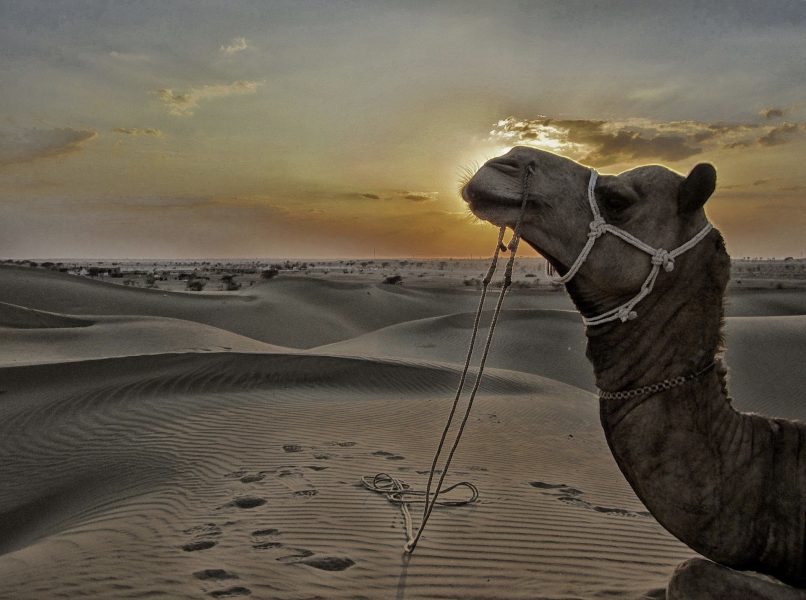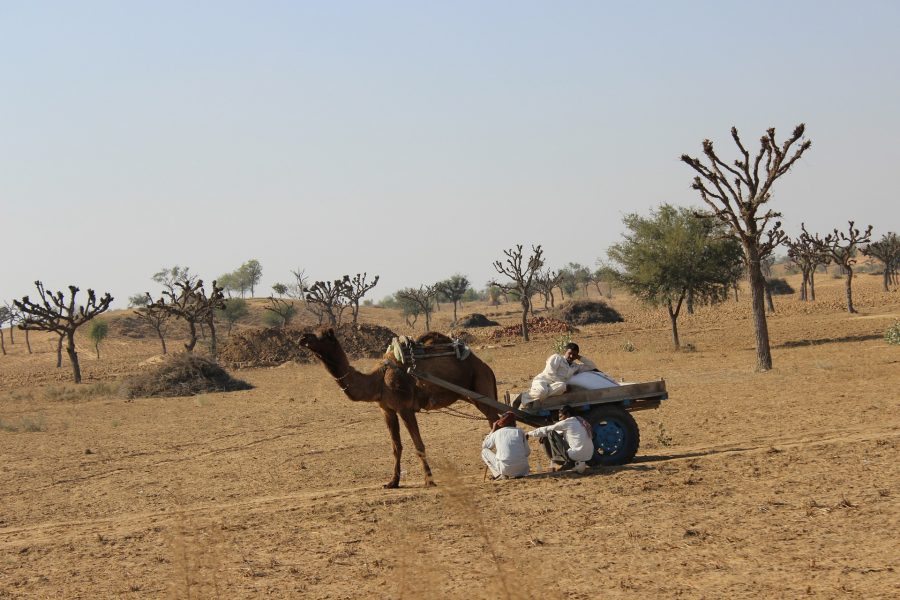
Rajasthan: Law meant to save camels is leading to its decline

Camels were once a prized possession for breeders in Rajasthan. Madhavram Raika, a breeder from Pali district, said that his father owned 150 camels. Of these, both young and adult male camels would be sold at a handsome price, sustaining the family for decades.
A law in 2015, the Rajasthan Camel (Prohibition of Slaughter and Regulation of Temporary Migration or Export) Act, that aimed to protect the state animal, however, is contributing to its downfall, lament breeders. The price of the animal has dipped so much and the losses have been so high that those like Madhavram have had to sell all their camels, even as others are struggling for sustenance, bringing down the total number of camels in the state significantly.
No glory after being crowned
“Koi fayda nahin hua (There has been no gain),” Madhavram said about the state government’s decision to declare the camel as the state animal back in 2014. “We thought that after being declared the state animal, our animals’ and our future would look brighter. But that has not been the case. On top of that, the 2015 law restricting selling our animals outside the state has caused the prices to dip by a large margin,” he said. Prices of camels have dropped by 80-90% from the price that they would fetch earlier.
Hariram Raika, another camel breeder from Manigar village in the same district, chipped in, “Before 2015 when the Act came into being,” he said, “an eight-ten-month-old camel would be sold for Rs. 15,000 or more. Now we hardly get Rs 3,000 for a three-four-year-old animal.” The animals would mostly be sold to buyers in Punjab, Haryana, Madhya Pradesh, Uttar Pradesh, and Himachal Pradesh. Most of them would be farmers who use the camel for agricultural purposes, or for milk; the camel is also used to carry heavy loads and for transportation.
The Raika community are pastoralists and have been known to herd camels for a livelihood for centuries. Hardships have come in many forms over the years, but the community has fought through it all. This time, however, their very source of sustenance is at risk.
Also read: Think big, act small: Every individual effort can contribute to sustainability
“In the Pushkar Mela in 2019, for instance, for the first time ever, there were more horses on sale. They fetched better prices,” Hanwant Singh Rathore, director of Lokhit Pashu Palak Sansthan, a body of camel breeders in Rajasthan, said. “A six-month-old camel calf was earlier sold at Rs. 10,000. Now it is sold at Rs 1000-1500. In desperation, people have begun selling their camels in hordes.” The Pushkar Mela, also known as the Pushkar Camel Fair, is an annual fair in which domestic animals, mostly camels, horses, and cattle are traded with buyers from across the country.
The 2015 law has changed that. As a result, the total camel population in the state has nosedived, Rathore said.
The 20th Livestock Census shows that in 2012, the total number of camels in the state was 3.25 lakh (325,000). By 2019, this number had dipped to 2.13 lakh (213,000), a dip of almost 35 percent in just seven years. “That’s the official census,” Rathore told Mongabay-India, “We estimate the number to be even lower, at 1.5 lakh (150,000). And it’s reducing every month.”
An effort to save backfired
Ironically, it was the camel breeders who wanted a law in place to prevent their animals from being sold outside the state, but they had two specific demands: that their animals should not be sold for slaughter, and that any kind of ban on sale should be applied only to female camels. “We heard about the first instance of camel slaughter in 2002. So we wanted a ban but only on the sale of female camels, who are the source of life,” Rathore said. “But when the Act was passed, there was a blanket ban on the sale of both male and female camels. This stopped all trade and hit us bad.”
The law, however, is not the only reason why camel breeders are struggling. Loss of grazing land for their animals is another reason. Pastoralists like Hariram Raika for instance said that for generations, their animals would graze openly and venture into the forests of Kumbalgarh for two months in a year, during the monsoons. “But once it was declared a wildlife sanctuary, we were no longer allowed,” he said.
Struggle for sustenance
“Earlier we would earn as much as Rs. 2-2.5 lakh (200,000-250,000) a year by selling our animals,” Hariram said, “Now (after the law) we make about Rs. 25,000-30,000. This has severely impacted our economic status.” From 60 camels, he now has 30, selling the rest in desperation since he could no longer afford their upkeep.
For Madhavram, things have been even more drastic. He now herds others’ camels, and earns a monthly income of Rs 8,000. His lowered economic prowess affected his family, leading to domestic problems, and finally forcing his wife to work as a daily wage worker to run their house.
Theirs are not uncommon stories. And the proof is in the depleting numbers of the camel. In a village called Ansh Ki Dhani in the Pali district where 100 families live, back in 1991, there were 5,000 camels. Now there are just 200. In another village called Jodhawar Ki Dhani, there were 7,000-8,000 camels about six years back; now there are just 300-400.
In most cases, breeders are now letting go of the male camels to fend for themselves, while trying to keep the females. There has been an unprecedented rise in the number of stray camels in recent times, Rathore said. In desperation, some people have resorted to selling their animals illegally, walking across the state border on foot for trade, he added.
In a bid to check the declining camel population, the state government started a Camel Development Scheme in 2016 to give an incentive of Rs. 10,000 for every newborn calf in three installments. Many breeders however could not avail of this incentive, and some did not get the final installment, making this scheme unsuccessful.

As an alternative means of livelihood, breeders have begun to sell camel milk. This was after much persuasion since it went against their traditional beliefs. Camel milk has often been touted as a superfood, claimed to be beneficial for autism, diabetes, liver disease, jaundice, even cancer. Camel Charisma is one such initiative through which breeders of the Lokhit Pashu Palak Sansthan now sell camel milk. “Through this, a family can earn between Rs. 18,000 to Rs. 30,000 a month,” Rathore said. Camel Charisma pays Rs. 60 per litre of camel milk to the breeders. They also make camel milk products like cheese and soap; even camel poop paper. Things, however, are moving slowly. Competitive pricing in comparison to cow’s milk or buffalo’s, and a lack of demand among the general populace because of inadequate marketing, they feel, is the reason behind this. Lack of infrastructure in the cold chain is another challenge.
Ilse Köhler-Rollefson, who has been engaged in camel research for more than 30 years and is a co-founder of Lokhit Pashu Palan Sanstan, added that there is a huge demand for camel milk outside India, “particularly China”, but because of lack of infrastructure, they haven’t been able to meet the need.
“We think that if the 2015 law is amended, we will be able to save our animals,” Hariram Raika said, “Otherwise the next five years will be critical for our camels.”
The state government had formed a committee to look into the issues after the camel breeders staged a protest against the ban during the 2019 Pushkar Mela. In the list of recommendations submitted thereafter, the breeders asked, in addition to amendment of the law, to include camel milk in mid-day meals in schools, to promote it in the market, and for free-range grazing rights.
Also read: Forest fires: Local communities best suited to protect, increase green cover
An official of the Animal Husbandry department has now assured that the process to amend the law is underway. “There is a proposal of amendments that have been cleared by the law ministry and will soon be introduced in the assembly,” the official told Mongabay-India. “The new provisions would be such that except for slaughter, breeders would be able to send their animals across the state’s borders and earn their revenue.” There is no estimate of when this would happen so it is still a wait-and-watch game for the camel breeders of Rajasthan.
(The story first appeared on Mongabay)

